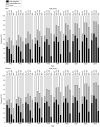Trends in the prevalence of diagnosed atrial fibrillation, its treatment with anticoagulation and predictors of such treatment in UK primary care
- PMID: 16387813
- PMCID: PMC1861124
- DOI: 10.1136/hrt.2005.069492
Trends in the prevalence of diagnosed atrial fibrillation, its treatment with anticoagulation and predictors of such treatment in UK primary care
Abstract
Objectives: To examine trends in the prevalence of diagnosed atrial fibrillation (AF), its treatment with oral anticoagulants between 1994 and 2003, and predictors of anticoagulant treatment in 2003.
Methods: Analysis of electronic data from 131 general practices (about one million registered patients annually) contributing to the DIN-LINK database.
Results: From 1994 to 2003 the prevalence of "active" AF rose from 0.78% to 1.31% in men and from 0.79% to 1.15% in women. The proportion of patients with AF taking anticoagulants rose from 25% to 53% in men and from 21% to 40% in women. Most others received antiplatelets. The likelihood of receiving anticoagulants was greater for men and with increasing stroke risk. It decreased sharply with age after 75 years. Socioeconomic status, urbanisation and region had no influence. Non-steroidal anti-inflammatory drugs, antiplatelet drugs and ulcer healing drugs were associated with reduced likelihood of receiving anticoagulants, as were peptic ulcers, chronic gut disorders, anaemias, psychoses and poor compliance. Anticoagulant treatment was associated with several cardiovascular co-morbidities and drugs, possibly due to secondary care treatment. Nevertheless, only 56.5% of patients at very high risk of stroke were taking anticoagulants in 2003, whereas 38.2% of patients at low risk of stroke received anticoagulants.
Conclusions: This study confirms previously observed trends of increasing AF prevalence and warfarin treatment. Many patients who may benefit from anticoagulation still do not receive it, whereas others at lower risk of stroke do. The lower likelihood of women receiving anticoagulants is of particular concern.
Conflict of interest statement
Competing interests: AstraZeneca funded this study and have interests in stroke prophylaxis. NR is a director of a company providing DIN‐LINK data for commercial purposes.
Comment in
-
Is quality of anticoagulation a 'wild card' in the treatment of patients with atrial fibrillation?Nat Clin Pract Cardiovasc Med. 2007 Feb;4(2):72-3. doi: 10.1038/ncpcardio0740. Epub 2007 Jan 16. Nat Clin Pract Cardiovasc Med. 2007. PMID: 17228289 No abstract available.
References
-
- Anon Stroke prevention in atrial fibrillation study: final results [see comment]. Circulation 199184527–539. - PubMed
-
- Fuster V, Ryden L E, Asinger R W.et al ACC/AHA/ESC guidelines for the management of patients with atrial fibrillation: executive summary. A Report of the American College of Cardiology/American Heart Association task force on practice guidelines and the European Society of Cardiology committee for practice guidelines and policy conferences (committee to develop guidelines for the management of patients with atrial fibrillation): developed in collaboration with the North American Society of Pacing and Electrophysiology, J Am Coll Cardiol 2001381231–1266. - PubMed
Publication types
MeSH terms
Substances
Grants and funding
LinkOut - more resources
Full Text Sources
Medical


